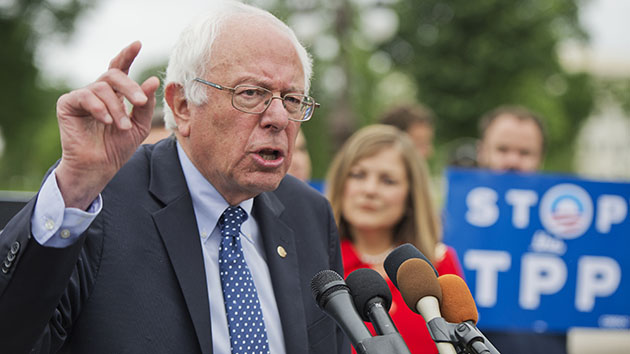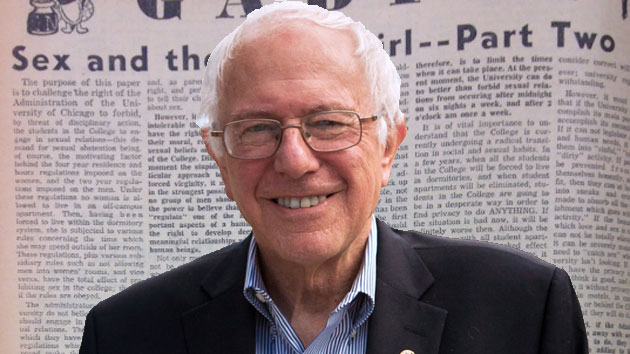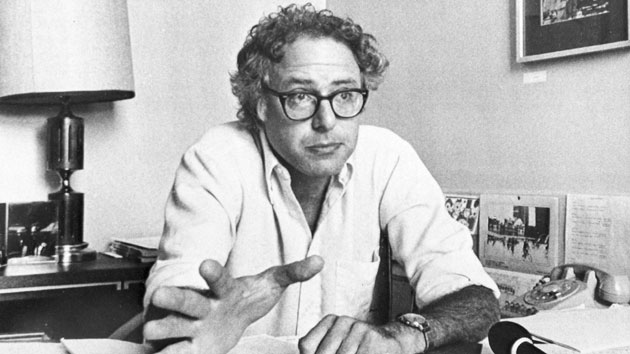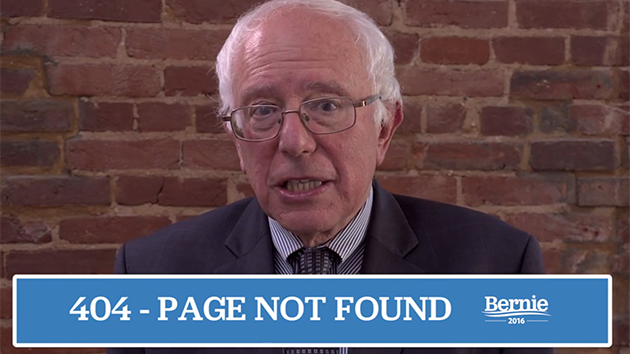
Jacquelyn Martin/AP
It’s fortunate for Hillary Clinton that Sen. Bernie Sanders, the independent socialist from Vermont who is challenging her for the Democratic presidential nomination, despises and eschews negative advertising. That’s because the political consulting firm that Sanders has retained to advise his campaign has a well-developed expertise in devising attack ads. Earlier this year, this outfit, Devine Mulvey Longabaugh, won a Pollie award from the American Association of Political Consultants for creating the best Democratic congressional ad of 2014. The spot slammed Dave Trott, a Republican running for a congressional seat in Michigan, for making millions of dollars by foreclosing on residents of his state, and it focused on the harrowing eviction of a 101-year-old Detroit woman. Trott survived this assault and handily won the seat in the Republican district, but the Washington Post called the commercial “one of the most brutal attack ads you’ll ever see.”
The Sanders campaign has no plans to hurl these kinds of ads at Clinton. As Tad Devine, the veteran political operative who leads this firm and a longtime adviser to Sanders, notes, mudslinging is not part of the campaign strategy that Sanders and his advisers have crafted. There won’t even be one speck of dust directly tossed at Clinton. But, Devine tells me, implicit negative messages aimed at Clinton will certainly be “embedded” in Sanders’ advertising and social media messaging.
Sanders does have an overall plan on how to beat Clinton. As Devine explains, it goes something like this: Raise enough money to devote significant resources to building a full operation and maintaining a media presence in the early states of Iowa and New Hampshire, as well as Nevada and South Carolina. At the same time, develop a basic foundation for campaign organizations in other states, so if Sanders fares well in the initial contests, these preliminary outfits can quickly be built out. Devine and other Sanders advisers estimate they will need to raise $40-$50 million by the Iowa caucuses to be in such a position, and they claim Sanders is on track to hit that mark, mainly with thousands and thousands of low-dollar contributions. (Sanders has drawn crowds of thousands at recent campaign events.) “I don’t know if we can outright beat her in Iowa and New Hampshire,” Devine says, “but we have a real shot at it in both places.”
And when—or if—that happens, Devine figures, Sanders will have about a million contributors already on his side, and this group will enthusiastically kick in more money to replenish Sanders’ coffers and fund the continuation of Bernie-mentum. “I worked for Walter Mondale in 1984,” Devine recalls, “but I saw what Gary Hart did.” Hart, a former senator who went up against Mondale in a bid for the Democratic presidential nomination, placed a surprising second in Iowa and won New Hampshire. “Things then moved fast. Some polls moved 50 points in seven days,” Devine says. (Mondale, though, did end up squelching the Hart insurgency by exploiting the Democratic establishment in key states.)
If Sanders does score well in the early states, Devine insists, his campaign will have a delegate-accumulation strategy reminiscent of the one Barack Obama’s 2008 campaign employed to focus as much on snagging delegates as winning caucuses and primaries. “Even if Clinton beats us in some states by 20 points, we can split the delegates with smart focusing,” Devine says. And then Sanders will be in a position to make the case to the Democratic establishment that he can assemble an electorate in the general election that is favorable to Democrats (as Obama did in 2008). “We don’t know yet what it will look like,” Devine remarks. “We haven’t done the strategic modeling yet. I’ve been trying to persuade Bernie we should do that.” Instead, he says, Sanders at this point would rather concentrate on promoting his message: Inequality is killing the middle class, climate change must be addressed, big-money politics must be reformed, and new progressive policy ideas, such as free college tuition and expanded Social Security benefits, must be advanced. (Devine also gave Sanders a PowerPoint presentation on how the campaign can use Big Data methods: “He was impressed, but we’re not sure we can scale up to that. We won’t have $1 billion.”)
And what about Clinton? How will Sanders take her on?
Sanders recently boasted that he has “never run a negative ad,” noting that he “hates and detests these 30-second negative ads.” Devine says this is part of Sanders’ DNA. “You need to know Bernie’s history with negative ads to get this,” Devine says. In 1988, when Sanders was the mayor of Burlington, Vermont, he ran for an open congressional seat as an independent and lost a close race to Republican Peter Smith. Two years later, Sanders was back to challenge Smith. In that 1990 race, Smith aired tough ads assailing Sanders, and Sanders’ aides advised him to hit back. Instead, Sanders bought airtime for a five-minute spot in which he talked straight to the camera and decried the attack ads. (It didn’t hurt Sanders that the National Rifle Association was slamming Smith for having voted for a ban on semi-automatic weapons.) Sanders ended up winning that race by 16 points. “This was his formative experience,” says Devine. “Negative ads have to be denounced and jiu-jitsued.”
During his 1994 re-election race, Sanders had a close call. He won by only three points. He responded by doing what he swore he would never do: He hired a Washington consultant, Devine. But he told Devine he would stick to his no-negative-ads stance. In the next election, Sanders aired only positive spots and won by 22 points.
Ten years later, Sanders ran for the Senate, with Devine still advising him. His Republican opponent was a millionaire businessman named Rich Tarrant who dumped about $7 million into the race in a state where, Devine says, no candidate had ever spent more than $2 million on a campaign. “It was a vicious campaign against Bernie,” Devine recalls. “He ran ads that accused Bernie of supporting child molesters and terrorists. Chuck Schumer and Harry Reid were telling Bernie, ‘You must respond.'” Sanders replied with an ad Devine had cut, in which Sanders noted he was being unfairly attacked and asked voters to visit his website to get the truth. Subsequent commercials by Sanders attempted to refute the stream of attack ads from Tarrant. The Sanders campaign also pushed an ad in which country singer Willie Nelson endorsed Sanders and cited his work for family farmers. Sanders beat Tarrant by more than a 2-1 margin.
So Sanders has survived and thrived in politics by neutralizing negative ads and resisting the urge to attack. And part of his shtick is that he doesn’t do conventional politics. So, Devine notes, he will not directly criticize or poke at Clinton. For sure, no personal attacks or cheap shots. “That won’t help him,” Devine says. “He rejects the status quo of politics.” Sanders won’t even do a straight-up contrast ad—as in, Bernie Sanders believes X about subject Y, but Hillary Clinton believes Z. “If we do that, we’re done,” Devine says. “If we do a classic comparative ad, it’s over. We’ll have to be smarter.”
And Team Sanders does have what it considers to be a smarter way: implying a contrast. In previous campaigns, Devine says, “We have constantly embedded contrast in everything we do.” One example: During the 2006 Senate race, Tarrant’s residence became a political issue because he had claimed a Florida mansion as his home for tax purposes. Sanders ran a biographical ad in which he declared he worked in Washington and lived in Burlington—an indirect jab at Tarrant. In the campaign against Clinton, Devine notes, “There will be a lot of implicit negative. But it won’t look negative. It won’t feel negative.”
That’s how Sanders recently handled the Trans-Pacific Partnership trade pact. He opposes the measure as a sop to corporate America and billionaires. Asked about Clinton’s view—she has referred positively to this trade deal in the past but more recently has avoided stating a firm position—Sanders didn’t proclaim that she’s in bed with the 1 percent; he called on her to take a clear stance. “It’s not a question of watching this,” he said. “You’re going to have determine which side are you on.” Devine points out that “this is not negative, but contrasting. When you offer voters a contrast on the issues, they don’t take that as a negative.” He adds that Sanders is “very good at this.”
Contrast without attacking—that’s the mantra. “As someone making the ads, it will be a difficult challenge,” Devine says. “We have to present the differences in the ads without him coming across as part of the political system.” Devine fears that if Sanders crosses that line, the Clinton campaign will fire back hard: “They have all the tonnage. We’re dead.”












